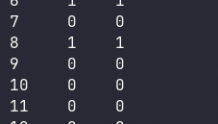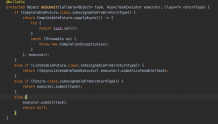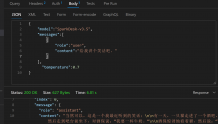运算符重载:与function overloading异曲同工的是,C++提供所谓的Operator overloading。所谓operators是像 +(加)-(減)*(乘)/(除)>>(位右移)
<<(位左移)之类的符号,代表一种动作。
面对operators,我们应该把他想像是一种函数,只不过形式比较特殊罢了。一般函数的参数出现在括号()之中,而operator的参数围绕着一个operator符号(之前或之后),编程语言内置的数据类型(比如整数`int`、浮点数`float`、长整数`long`等)所使用的操作符(比如加法`+`、减法`-`、乘法`*`等)是由语言本身直接提供的,而不是通过任何外部库或模块来实现的。
C++允许程序员为class type's object设计专门的operators,使objects的操作能够像内建型别的一样的自然而直观。让operator以种形式呈现,但符号不变,这个就是operator overloading。
Operator overloading的存在一下褒贬不一,支持者认为它使得程序代码变得更精简漂亮,反对者认为容易把程序员搞迷糊掉。但是,我想,谁都不可否认下面这样的程序代码确实是精简漂亮:
CString str1("Hello, I am J.J.Hou, "); CString str2("How are you?"); CString str3 = str1 + str2; // + 是 CString的一个overloaded operator // 于是 str3 为 "Hello, I am J.J.Hou, How are you?" int i = 5; double pi = 3.141592653; cout << "i=" << i << " and pi=" << pi << endl; // 于是 console 屏幕上出现"i=5 and pi=3.141592653"。
现在让我示范一个overloaded operator的作法,只要在以下类的代码中加入第18~21行的+号的重载代码,即可完成CPoint的加法运算:
1 class CPoint{ 2 3 public: 4 5 CPoint() 6 { 7 _x=0; 8 9 } 10 11 CPoint(float y){ 12 13 _x=y; 14 } 15 float x(){return _x;} 16 void x(float xval){_x=xval;} 17 18 CPoint operator+(const CPoint& pt) const //对+号进行重载 19 { 20 return CPoint(_x+pt._x); 21 } 22 23 protected: 24 float _x; 25 26 };
以operator开头的函数,表示是个运算子。加法运算子需要左右两个运算元(operands),左侧运算元即成为本函数的this指向的对象,右侧运算元则是本函数的参数pt。上述函数代码如果像下面这样表示,会比较清晰,但两者其实是相同的(因为this指针是个隐藏参数):
CPoint operator+(const CPoint& pt) const //对+号进行重载 { return CPoint(this->_x+pt._x); }
有了上述的 CPoint::operator+,现在你可以这么使用它:
1 CPoint pt1(7.2), pt2(5.3), pt3; 2 pt3 = pt1 + pt2; 3 cout << "pt3.x = " << pt3.x() << endl; // 12.5
C++中,<<和>>是最常用的重载运算符,用于表示对标准输入输出设备(如屏幕和键盘)的读写操作,极大地方便了编程,可替代繁琐的printf()和scanf()函数。这两个运算符在iostream库中定义,为C++编程提供了极大的便利。
Insertion Operator( <<) for stdout: <<本来是位左移运算符,但是在C++的标准库iostream中被改头换面,其左侧的运算元(operand)被指定为cout(console output device),右侧运算元是一个内建型别的objects。我们可以利用它很方便的对cout连续输出各种内建型别的数据或信息(也是一种objects),不必像C程序那样需要识别不同类型的数据在printf()中的格式符号(如 %s、%d、%f...):
1 #include <iostream.h> 2 ... 3 int i = 5; 4 double pi = 3.141592653; 5 cout << "i=" << i << " and pi=" << f << endl;
Extraction Operator(>>) for stdin:>>本来是位右移运算符,但在C++标准的iostream中被改头换面,其左侧运算元是cin(console input device),右侧运算元是一个内建型别的object。例如:
1 #include <iostream.h> 2 ... 3 float f; 4 cout << "f = ? "; 5 cin >> f;
程序使用者在健盘上输入,会经由cin装置流往f变量,其作用相当于C runtime library中的scanf()。
Insertion Operator( <<) for file:就像iostream支持对user‘s terminal的输入输出一样,c++另有一组class types支持对文件的输入输出:
1.ifstream衍生自istream,支持文件的输入。
2.ofstream衍生自 ostream,支持文件的输出。
3. fstream衍生自 iostream, 支持文件的输入输出。
如果需要这些class type,必须导入对应的header file。请注意,fstream已经含有iostream,所以不需要重复导入;
下面是信息输入到文件的案例:
#0001 #include <fstream.h> // include iostream.h #0002 #0003 int main() #0004 { #0005 cout << "All your keyboard input in monitor " #0006 << "will into copy.txt.n" #0007 << "Terminate by ^Znn"; #0008 #0009 ofstream outFile("copy.txt"); #0010 if (!outFile) { #0011 cout << "Cannnot open copy.txt for output" << endl; #0012 return -1; #0013 } #0014 #0015 char c; #0016 while (cin.get(c)) // get each char from keyboard #0017 outFile << c; // outFile.put(c) 亦 可 #0018 #0019 return 0; #0020 }
当程序执行后,会先提示输入,然后接收所有来自于键盘的字符,一一放进”copy.txt"文件中,直到接收到^z 才停止。
Extraction Operator( >>) for file:下面是将文件的内案输出到屏幕上的示例:
#0001 #include <fstream.h> // include iostream.h #0002 #0003 int main() #0004 { #0005 cout << "All text in copy.txt " #0006 << "will stream into monitor.nn"; #0007 #0008 ifstream inFile("copy.txt"); #0009 if (!inFile) { #0010 cout << "Cannnot open copy.txt for input" << endl; #0011 return -1; #0012 } #0013 #0014 char c; #0015 while (inFile.get(c)) // get each char from file #0016 cout.put(c); // output to monitor #0017 #0018 return 0; #0019 }
当程序执行后,会先给一个提示,然后从文件 "copy.txt" 中一一读出每一个字符,显示于屏幕上。上述第0015行如果改为while (inFile >> c) // get each char from file,虽然也能读出字符,但空格会被忽略,这个并非我们所想要的。






